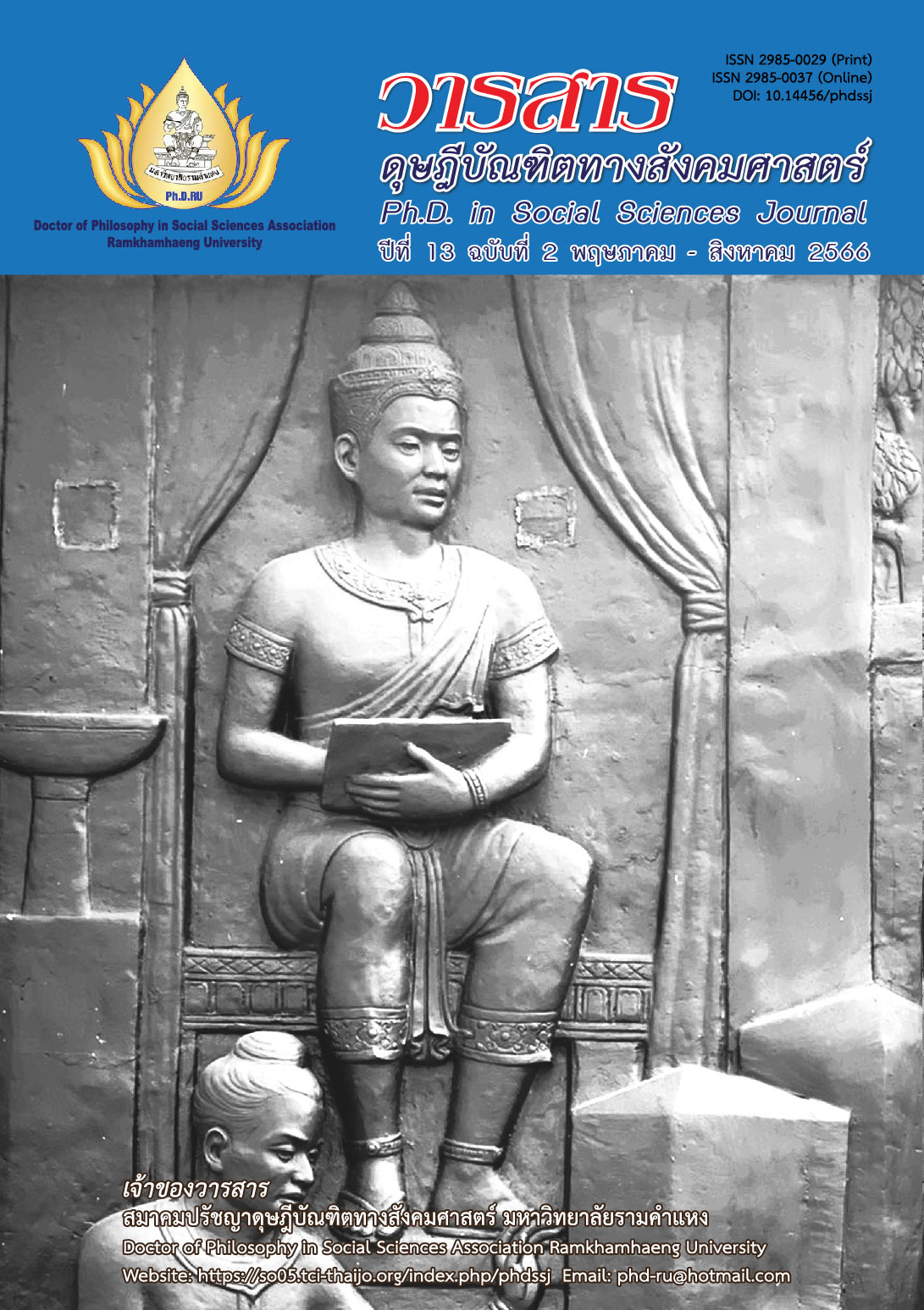The Influence of Perceived Risk, Trust and Attitude Toward Online Purchasing on Behavior Purchasing Intention of Generation Y Consumers in Thailand
Main Article Content
Abstract
This research article aims to study (1) the influence of perceived risk on trustworthiness and attitude toward online purchases; (2) the influence of trustworthiness on attitudes toward online purchases; and (3) the influence of online purchasing attitudes on behavioral purchase intent. It’s mixed research. Both quantitatively and qualitatively, they are generation Y consumers who buy goods and services online. A sample of 420 people used an online questionnaire to collect data. Data were analyzed by content analysis and SEM structural equation analysis.
Findings are as follows: It can be concluded that the results of this analysis are consistent with the empirical data. Index value χ2 = 129.18, χ2/df = 1.14, p-value = 0.14, RMSEA = 0.01, CFI = 1.00, NFI = 1.00 and SRMR = 0.01. The highest was 0.97, followed by risk perception had a direct influence on attitude towards online buying was 0.58 and trustworthiness had a direct influence on behavioral purchase intent was 0.54 with statistical significance at the level of .01 respectively. In the qualitative research findings, risk perception influencing trust credibility online shopping attitudes and behavioral purchase intentions of generation Y consumers. The seller must reassure or create relationship marketing with customers.
Article Details

This work is licensed under a Creative Commons Attribution-NonCommercial-NoDerivatives 4.0 International License.
Academic articles, research articles, and book reviews in the Ph.D. in Social Sciences Journal are author’s opinions, and not the publisher’s, and is not the responsibility of the Ph.D. in Social Sciences Journal Philosophy Association, Ramkhamhaeng University. (In the case that research is done on human, the researcher has to be trained in Ethics for Doing Research on Human Training and has to produce the evidence of the training).
References
Ajzen, I. (1991). The theory of planned behavior. Organizational Behavior and Human Decision Processes, 50(2), 179-211.
Ajzen, I. (2002). Perceived behavioral control, self-efficacy, locus of control, and the theory of planned behavior 1. Journal of Applied Social Psychology, 32(4), 665-683.
Bauer, R. A. (1960). Consumer behavior as risk taking. In R. S. Hancock (Ed.), Dynamic marketing for a changing world (pp. 389-398). Proceedings of the 43rd. Conference of the American Marketing Association.
Belch, G. E., & Belch, M. A. (2004). Advertising and promotion: An integrated marketing communications perspective (6th ed.). McGraw-Hill.
Bilgihan, A. (2016). Gen Y customer loyalty in online shopping: An integrated model of trust, user experience and branding. Computers in Human Behavior, 61, 103-113.
Crano, W. D., & Prislin, R. (2011). Attitudes and attitude change. Psychology Press.
Creswell, J. W. (1999). Mixed-method research: Introduction and application. In Handbook of educational policy (pp. 455-472). Elsevier.
Diamantopoulos, A., & Siguaw, J. A. (2006). Formative versus reflective indicators in organizational measure development: A comparison and empirical illustration. British Journal of Management, 17(4), 263-282.
Dimock, M. (2018). Defining generations: Where millennials end and post-millennials begin. Pew Research Center.
Ðkudienë, V., Èertokas, Ð., McCorkle, D., & Reardon, J. (2015). The effect of e-shops’ service quality on lithuanian consumers’ purchase intentions. International Journal of Business, Marketing, and Decision Science, 8(1), 43-60.
Engel, J. F., Blackwell, R. D., & Miniard, P. W. (1995). Consumer behavior (8th ed.). Dryden.
Electronic Transactions Development Agency. (2020). Thrive in the new normal & GO Digital. Retrived form https://www.etda.or.th/th/Useful-Resource/documents-for-download.aspx [In Thai]
Google Forms. (2022). Influence of perceived risks, trust and attitude towards online product and service purchase on behavioral intention to purchase of Generation Y consumers in Thailand. Retrived from https://docs.google.com/forms/d/1oZcBmlpkbViZNwv8qYJADuvv0m4ffq5FzZ79yIBLCKs/edit [In Thai]
Gopi, M., & Ramayah, T. (2007). Applicability of theory of planned behavior in predicting intention to trade online: Some evidence from a developing country. International Journal of Emerging Markets, 2(4), 348-360.
Joreskog, K. G., Sorbom, D., Du Toit, S., & Du Toit, M. (1999). LISREL 8: New statistical features. Scientific Software International.
Kim, S. Y., & Park, S. Y. (1999). A study of decision factors for purchase intention at the electronic commerce. Journal of Consumer Studies, 10(3), 45-66.
Kochanski, G. (2006). Doing statistics by Rule-of-Thumb. Retrived from https://kochanski.org/gpk/teaching/0601Oxford/Rule_of_Thumb.pdf
Kotler, P., & Armstrong, G. (2010). Principles of marketing. Pearson Education.
Lin, P.-C., Hou, H.-T., Wang, S.-M., & Chang, K.-E. (2013). Analyzing knowledge dimensions and cognitive process of a project-based online discussion instructional activity using Facebook in an adult and continuing education course. Computers & Education, 60(1), 110-121.
Ministry of Digital Economy and Society. (2021). Building trust in e-Commerce. Retrived from https://www.mdes.go.th/service?a=31 [In Thai]
Mozes, T., & Weimann, G. (2010). The e-marketing strategy of Hamas. Studies in Conflict & Terrorism, 33(3), 211-225.
Muryjas, P., & Muryjas, M. (2013). Usage of IT tools in e-marketing campaign design and management in small and medium-sized enterprises. Studies and Proceedings Polish Association for Knowledge Management, 67, 70-83.
Newstrom, J. W., & Davis, K. (2002). Organizational behavior. McGrawHill.
Official Statistics Registration Systems. (2021). Demographic information B.E.2564 (demographic information, issue). Retrived from https://stat.bora.dopa.go.th/stat/statnew/statMenu/newStat/home.php [In Thai]
Pavlou, P. A. (2003). Consumer acceptance of electronic commerce: Integrating trust and risk with the technology acceptance model. International Journal of Electronic Commerce, 7(3), 101-134.
Pi, S.-M., & Sangruang, J. (2011). The perceived risks of online shopping in Taiwan. Social Behavior and Personality: An International Journal, 39(2), 275-286.
Van den Bergh, J., & Behrer, M. (2016). How cool brands stay hot: Branding to Generations Y and Z. Kogan Page.
Zhu, D. S., Chih, Z., O’Neal, G. S., & Chen, Y. H. (2011). Mr. Risk! please trust me: Trust antecedents that increase online consumer purchase intention. Journal of Internet Banking and Commerce, 16(3), 1-23.


